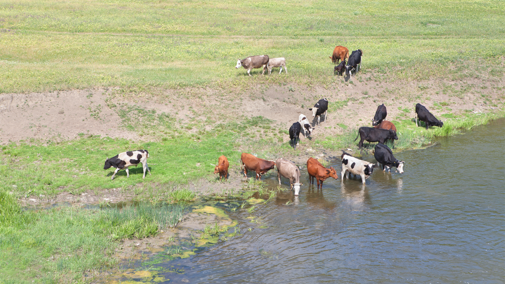Grazing Summer Annual Forages
Summer annual forages such as sudangrass, sorghum-sudan hybrids and pearl millet planted this spring soon could be ready to graze. There are some grazing guidelines to help avoid potential hazards.
The first guideline is to never turn hungry animals into sudangrass or sorghum-type pastures. The reason why is because they may eat so rapidly that they could get a quick overdose of prussic acid and die. All sudangrass and sorghum-type hybrids can produce a compound called prussic acid that is potentially poisonous. Prussic acid, which also is called cyanide, is nothing to fear though, as long as you use a few precautions to avoid problems.
The highest concentration of prussic acid is in new young shoots, so let your grass get a little growth on it before grazing to help dilute out the prussic acid. Let sudangrass get 15 to 18 inches in height before grazing. Sorghum-sudan hybrids usually have a little more prussic acid risk, so wait until they are 18 to 24 inches tall.
Pearl millet does not contain prussic acid so if you planted millet these grazing precautions aren’t needed. Pearl millet can be grazed when it reaches 12 to 15 inches tall.
Nitrates also can accumulate in these grasses, particularly when there are droughty conditions and/or excess nitrogen fertilization. Avoid grazing these grasses too short, since nitrate concentration is highest in the lower parts of the stems.
Summer annual grasses respond best to a simple, rotational grazing system. Divide fields into three or more smaller paddocks of a size that your animals can graze down to about eight or so inches of leafy stubble within seven to 10 days. Repeat this procedure with all paddocks. If grass in some paddocks gets too tall, it could be cut for hay.
A well-planned start, a good rotation, and a little rain can give you good pasture from these grasses all the rest of the summer.
Control of Flies in Pasture and Rangeland
In Nebraska, there are two species of fly that cause the most economic injury to pasture and rangeland cattle. They are the horn fly and face fly. Selection of an appropriate control method for each will depend on the time of year; the efficacy, cost, and convenience of the treatment; and your herd management practices.
The horn fly is a major pest that is estimated to cause over $1 billion in economic losses in the U.S. annually. It is a blood-feeding insect found on the back, sides and poll area of the animal. The economic injury level of the horn fly is 200 flies per animal that, once surpassed, causes altered grazing patterns and behavior, which lead to reduced milk production and weight gain.
While the face fly is not a blood feeder, it can cause extreme discomfort by feeding on animal secretions from the eyes, mouth and muzzle. It is also a vector of the pathogen that causes pinkeye in cattle and feeding by the female fly causeing eye tissue damage. Face fly populations usually peak in late July and August and are most common near waterways, in areas of significant rainfall and in irrigated pastures.
Horn fly and face fly management options vary widely and include forced use methods such as dust bags, back rubbers, and traps as well as product application methods such as pour-ons, animal sprays, and insecticide ear tags. For more information on control methods contact your county Extension office.
Water Quality and Blue-green Algae
When cattle are on pasture, both forage and water quality are important for healthy animals. Surface water is particularly prone to quality issues, such as blue-green algae, salinity, mineral concentrations, or nitrate.
Several factors can cause livestock water to be less than ideal for quality, which can impact animal productivity and health. While not common in Nebraska, salinity or minerals can cause animals to limit or refuse consumption in some locations. In some circumstances, concentrations can become high enough to be toxic. Dissolved salt and mineral concentrations increase with dry conditions as water evaporates.
Another issue more common in Nebraska surface water is high nitrates. While elevated nitrates from groundwater sources feeding a pond may be a cause, more common is runoff from other sources of nitrate contamination. Cattle can deal with nitrate levels in water that are unsafe for human consumption, but the real danger comes from elevated nitrate levels in water coupled with feed sources that are also high in nitrates. The compounding effect can push a borderline ration into toxic levels or accelerate nitrate toxicity that is already occurring.
Blue-green algae is a very common occurrence in still water during the summer months. If the conditions are right, a bloom of growth can occur quickly, contaminating the water. Consumption can kill livestock within 24 hours. Algae blooms have traditionally been treated with copper sulfate following proper instructions for rates and exclusions. However, when booms become more frequent, repeated copper treatments can cause a buildup of the element in the environment and animal management becomes our preferred response.
Assuring water is good quality will go a long way toward making summer grazing better and healthier cattle.

